Little Dessert Shop: Business Analysis Report on Partnership
VerifiedAdded on 2023/01/05
|8
|2080
|33
Report
AI Summary
This report provides a comprehensive analysis of Little Dessert Shop, a partnership business located in Birmingham. It begins by evaluating the partnership structure, discussing its advantages such as ease of establishment and shared investment, and disadvantages like potential disagreements and shared liability. The report then applies Porter's Five Forces framework to assess the competitive environment, examining the threats of new entrants, substitutes, and industry rivalry, along with the bargaining power of buyers and suppliers. Finally, it explores the macro-environmental factors affecting the shop, including economic, social, and environmental considerations, highlighting opportunities such as increasing health consciousness and the importance of environmental safety. The conclusion emphasizes the complexity of the business environment and the importance of knowledge and skills for success.

Individual report based on a
case study
case study
Paraphrase This Document
Need a fresh take? Get an instant paraphrase of this document with our AI Paraphraser
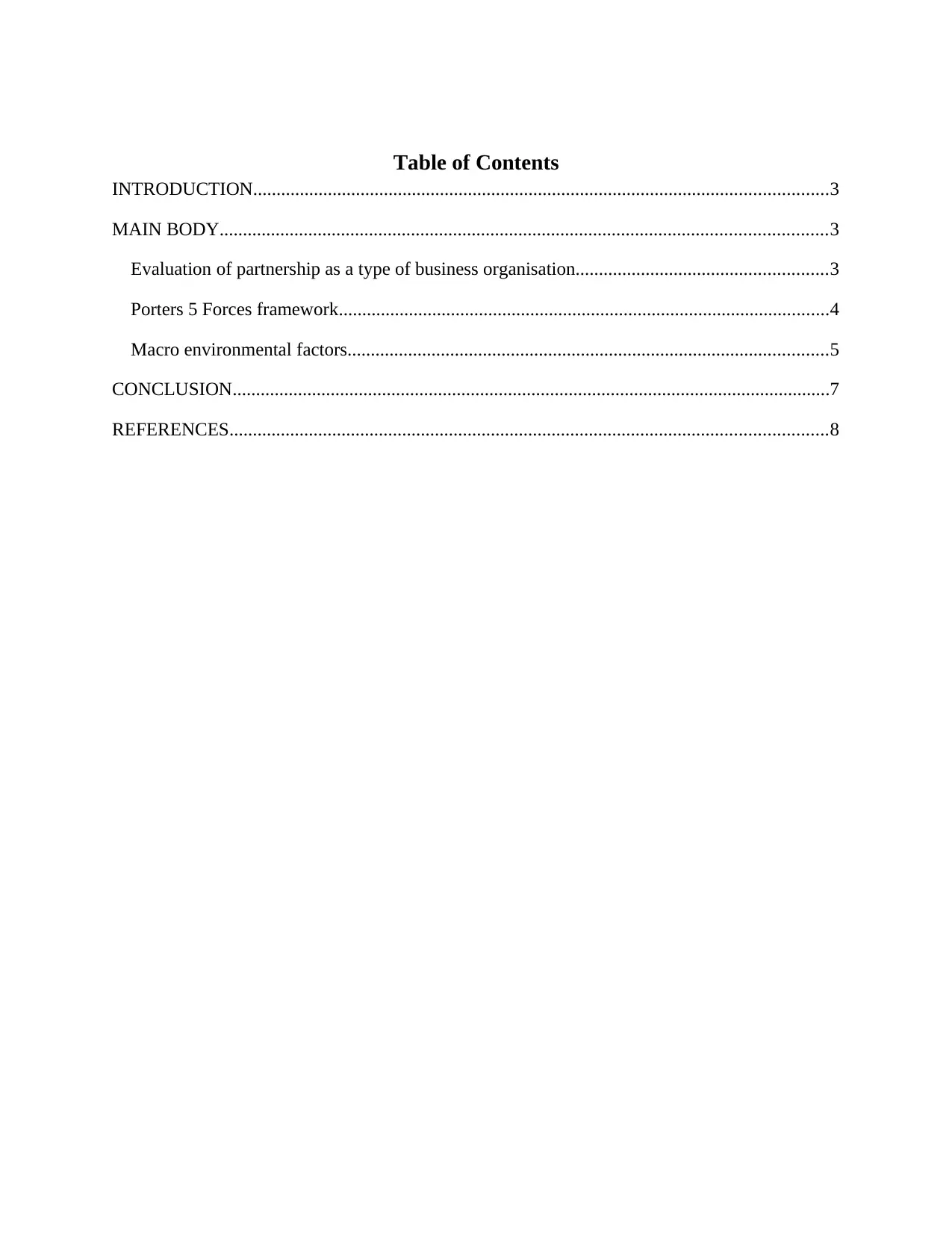
Table of Contents
INTRODUCTION...........................................................................................................................3
MAIN BODY..................................................................................................................................3
Evaluation of partnership as a type of business organisation......................................................3
Porters 5 Forces framework.........................................................................................................4
Macro environmental factors.......................................................................................................5
CONCLUSION................................................................................................................................7
REFERENCES................................................................................................................................8
INTRODUCTION...........................................................................................................................3
MAIN BODY..................................................................................................................................3
Evaluation of partnership as a type of business organisation......................................................3
Porters 5 Forces framework.........................................................................................................4
Macro environmental factors.......................................................................................................5
CONCLUSION................................................................................................................................7
REFERENCES................................................................................................................................8
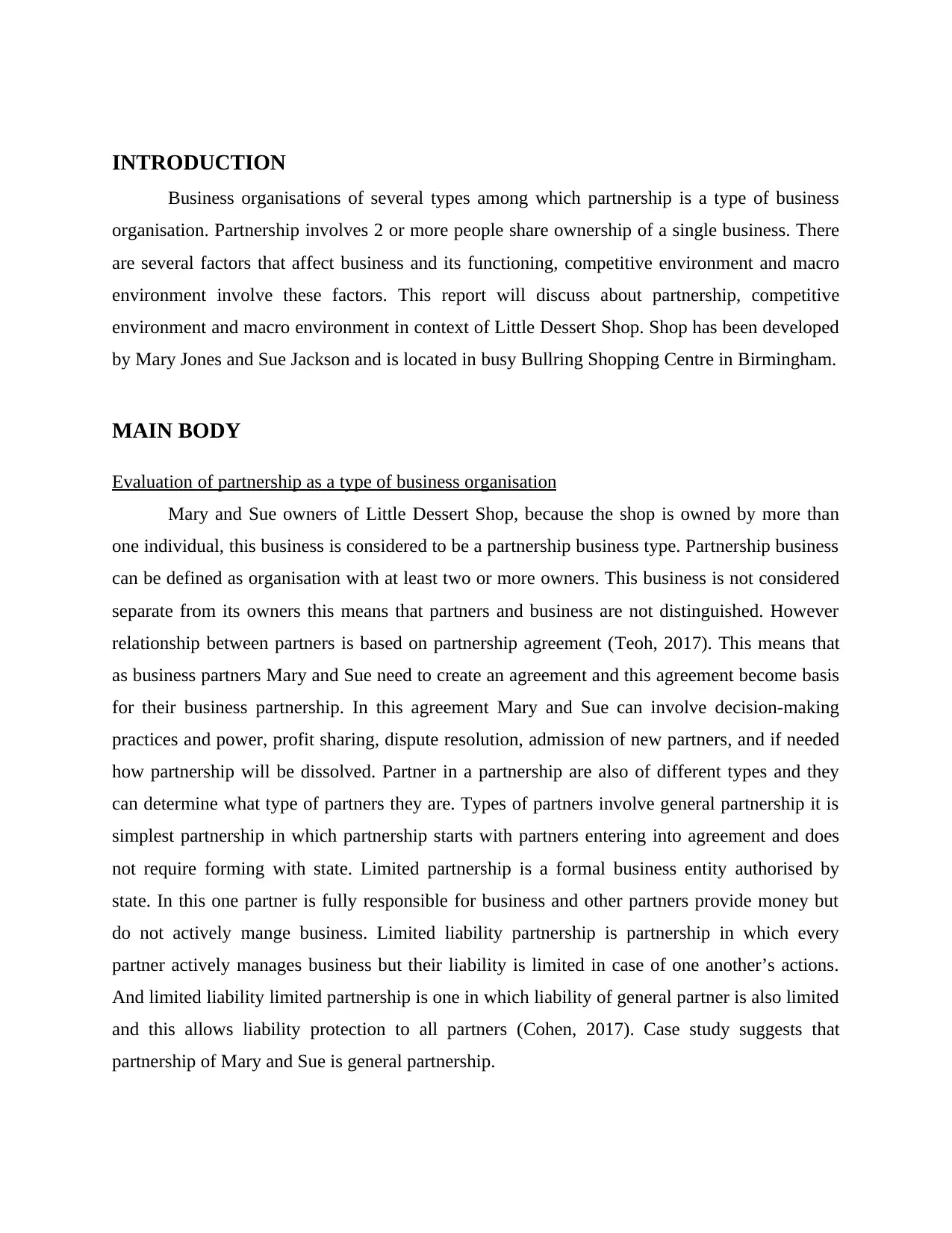
INTRODUCTION
Business organisations of several types among which partnership is a type of business
organisation. Partnership involves 2 or more people share ownership of a single business. There
are several factors that affect business and its functioning, competitive environment and macro
environment involve these factors. This report will discuss about partnership, competitive
environment and macro environment in context of Little Dessert Shop. Shop has been developed
by Mary Jones and Sue Jackson and is located in busy Bullring Shopping Centre in Birmingham.
MAIN BODY
Evaluation of partnership as a type of business organisation
Mary and Sue owners of Little Dessert Shop, because the shop is owned by more than
one individual, this business is considered to be a partnership business type. Partnership business
can be defined as organisation with at least two or more owners. This business is not considered
separate from its owners this means that partners and business are not distinguished. However
relationship between partners is based on partnership agreement (Teoh, 2017). This means that
as business partners Mary and Sue need to create an agreement and this agreement become basis
for their business partnership. In this agreement Mary and Sue can involve decision-making
practices and power, profit sharing, dispute resolution, admission of new partners, and if needed
how partnership will be dissolved. Partner in a partnership are also of different types and they
can determine what type of partners they are. Types of partners involve general partnership it is
simplest partnership in which partnership starts with partners entering into agreement and does
not require forming with state. Limited partnership is a formal business entity authorised by
state. In this one partner is fully responsible for business and other partners provide money but
do not actively mange business. Limited liability partnership is partnership in which every
partner actively manages business but their liability is limited in case of one another’s actions.
And limited liability limited partnership is one in which liability of general partner is also limited
and this allows liability protection to all partners (Cohen, 2017). Case study suggests that
partnership of Mary and Sue is general partnership.
Business organisations of several types among which partnership is a type of business
organisation. Partnership involves 2 or more people share ownership of a single business. There
are several factors that affect business and its functioning, competitive environment and macro
environment involve these factors. This report will discuss about partnership, competitive
environment and macro environment in context of Little Dessert Shop. Shop has been developed
by Mary Jones and Sue Jackson and is located in busy Bullring Shopping Centre in Birmingham.
MAIN BODY
Evaluation of partnership as a type of business organisation
Mary and Sue owners of Little Dessert Shop, because the shop is owned by more than
one individual, this business is considered to be a partnership business type. Partnership business
can be defined as organisation with at least two or more owners. This business is not considered
separate from its owners this means that partners and business are not distinguished. However
relationship between partners is based on partnership agreement (Teoh, 2017). This means that
as business partners Mary and Sue need to create an agreement and this agreement become basis
for their business partnership. In this agreement Mary and Sue can involve decision-making
practices and power, profit sharing, dispute resolution, admission of new partners, and if needed
how partnership will be dissolved. Partner in a partnership are also of different types and they
can determine what type of partners they are. Types of partners involve general partnership it is
simplest partnership in which partnership starts with partners entering into agreement and does
not require forming with state. Limited partnership is a formal business entity authorised by
state. In this one partner is fully responsible for business and other partners provide money but
do not actively mange business. Limited liability partnership is partnership in which every
partner actively manages business but their liability is limited in case of one another’s actions.
And limited liability limited partnership is one in which liability of general partner is also limited
and this allows liability protection to all partners (Cohen, 2017). Case study suggests that
partnership of Mary and Sue is general partnership.
⊘ This is a preview!⊘
Do you want full access?
Subscribe today to unlock all pages.

Trusted by 1+ million students worldwide
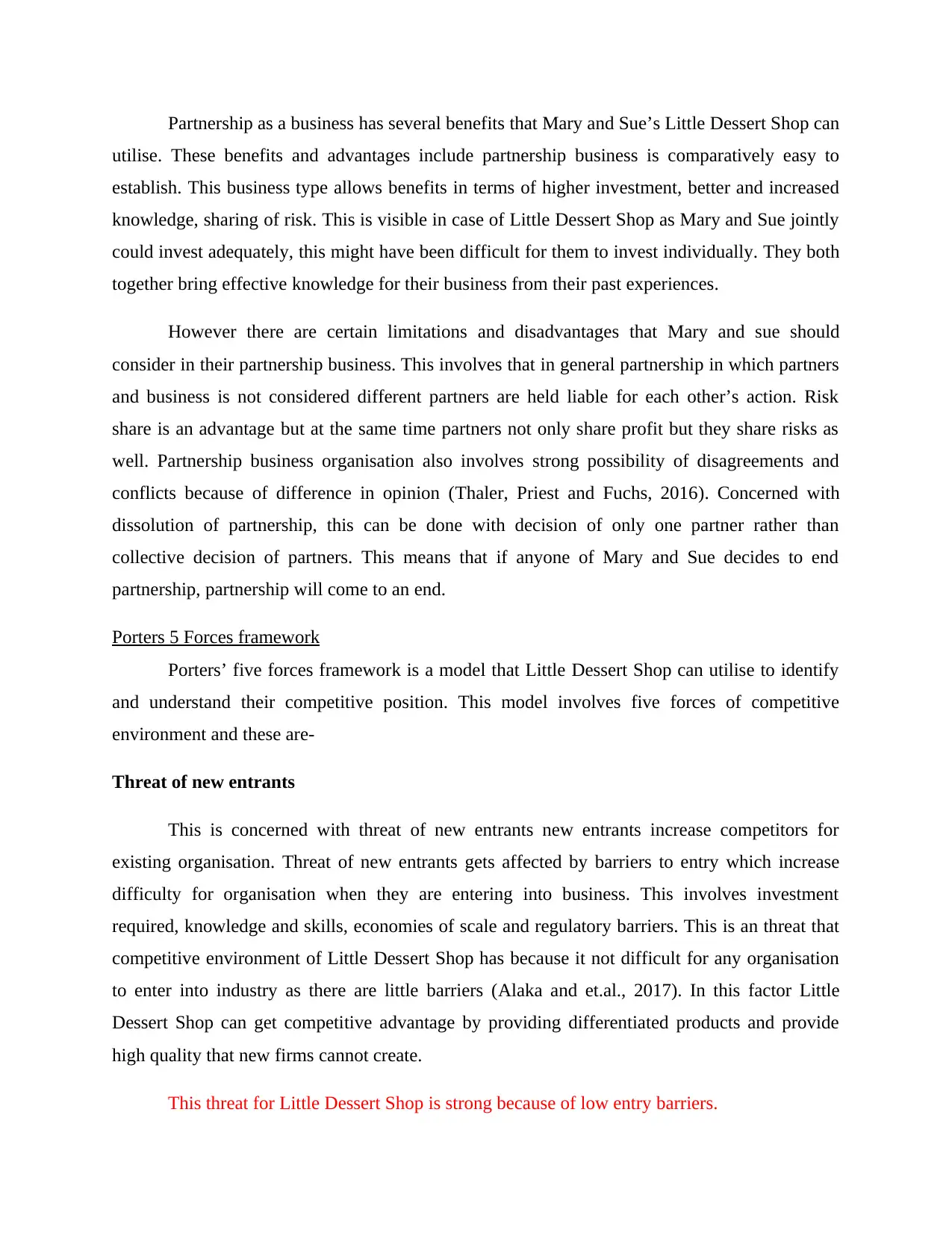
Partnership as a business has several benefits that Mary and Sue’s Little Dessert Shop can
utilise. These benefits and advantages include partnership business is comparatively easy to
establish. This business type allows benefits in terms of higher investment, better and increased
knowledge, sharing of risk. This is visible in case of Little Dessert Shop as Mary and Sue jointly
could invest adequately, this might have been difficult for them to invest individually. They both
together bring effective knowledge for their business from their past experiences.
However there are certain limitations and disadvantages that Mary and sue should
consider in their partnership business. This involves that in general partnership in which partners
and business is not considered different partners are held liable for each other’s action. Risk
share is an advantage but at the same time partners not only share profit but they share risks as
well. Partnership business organisation also involves strong possibility of disagreements and
conflicts because of difference in opinion (Thaler, Priest and Fuchs, 2016). Concerned with
dissolution of partnership, this can be done with decision of only one partner rather than
collective decision of partners. This means that if anyone of Mary and Sue decides to end
partnership, partnership will come to an end.
Porters 5 Forces framework
Porters’ five forces framework is a model that Little Dessert Shop can utilise to identify
and understand their competitive position. This model involves five forces of competitive
environment and these are-
Threat of new entrants
This is concerned with threat of new entrants new entrants increase competitors for
existing organisation. Threat of new entrants gets affected by barriers to entry which increase
difficulty for organisation when they are entering into business. This involves investment
required, knowledge and skills, economies of scale and regulatory barriers. This is an threat that
competitive environment of Little Dessert Shop has because it not difficult for any organisation
to enter into industry as there are little barriers (Alaka and et.al., 2017). In this factor Little
Dessert Shop can get competitive advantage by providing differentiated products and provide
high quality that new firms cannot create.
This threat for Little Dessert Shop is strong because of low entry barriers.
utilise. These benefits and advantages include partnership business is comparatively easy to
establish. This business type allows benefits in terms of higher investment, better and increased
knowledge, sharing of risk. This is visible in case of Little Dessert Shop as Mary and Sue jointly
could invest adequately, this might have been difficult for them to invest individually. They both
together bring effective knowledge for their business from their past experiences.
However there are certain limitations and disadvantages that Mary and sue should
consider in their partnership business. This involves that in general partnership in which partners
and business is not considered different partners are held liable for each other’s action. Risk
share is an advantage but at the same time partners not only share profit but they share risks as
well. Partnership business organisation also involves strong possibility of disagreements and
conflicts because of difference in opinion (Thaler, Priest and Fuchs, 2016). Concerned with
dissolution of partnership, this can be done with decision of only one partner rather than
collective decision of partners. This means that if anyone of Mary and Sue decides to end
partnership, partnership will come to an end.
Porters 5 Forces framework
Porters’ five forces framework is a model that Little Dessert Shop can utilise to identify
and understand their competitive position. This model involves five forces of competitive
environment and these are-
Threat of new entrants
This is concerned with threat of new entrants new entrants increase competitors for
existing organisation. Threat of new entrants gets affected by barriers to entry which increase
difficulty for organisation when they are entering into business. This involves investment
required, knowledge and skills, economies of scale and regulatory barriers. This is an threat that
competitive environment of Little Dessert Shop has because it not difficult for any organisation
to enter into industry as there are little barriers (Alaka and et.al., 2017). In this factor Little
Dessert Shop can get competitive advantage by providing differentiated products and provide
high quality that new firms cannot create.
This threat for Little Dessert Shop is strong because of low entry barriers.
Paraphrase This Document
Need a fresh take? Get an instant paraphrase of this document with our AI Paraphraser
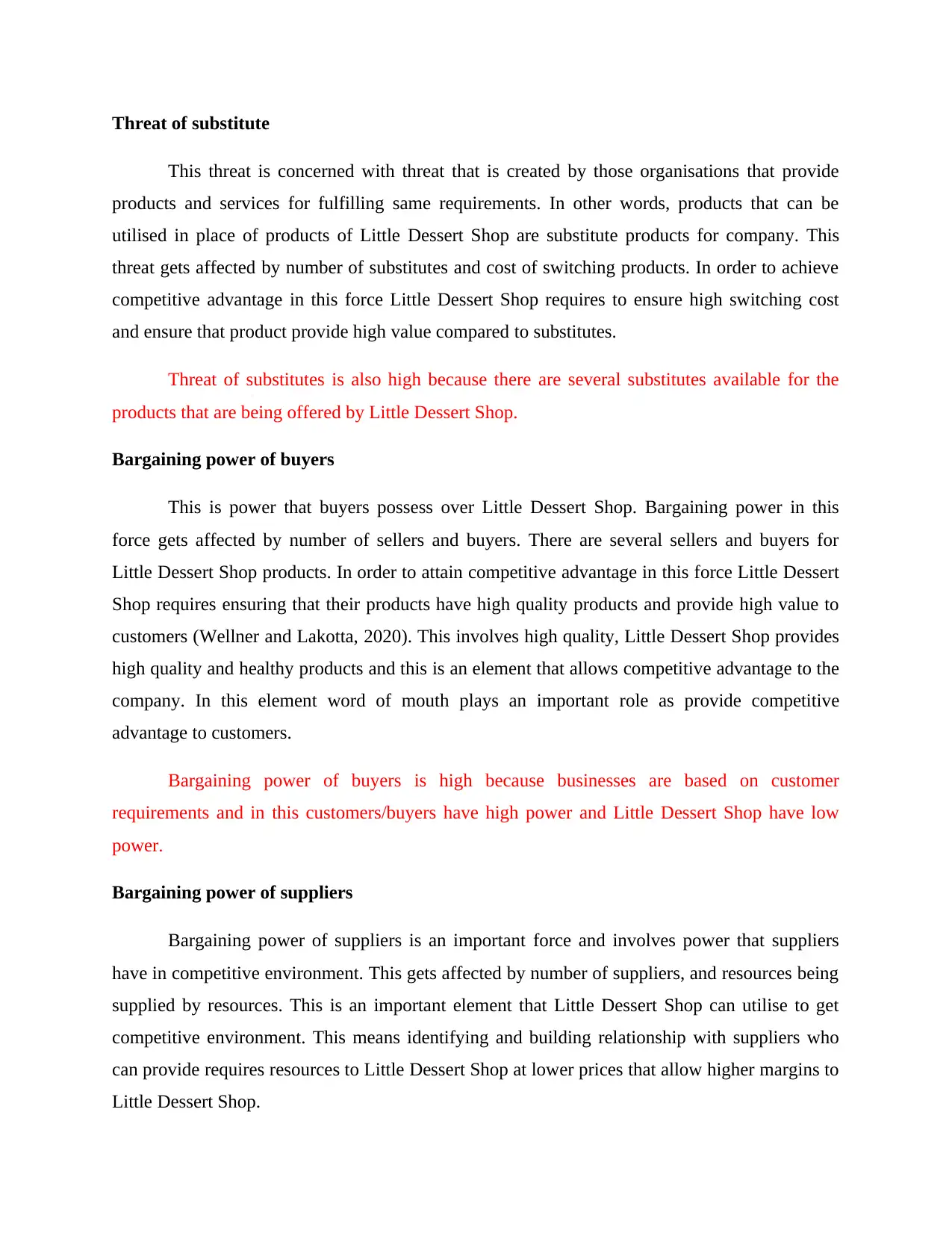
Threat of substitute
This threat is concerned with threat that is created by those organisations that provide
products and services for fulfilling same requirements. In other words, products that can be
utilised in place of products of Little Dessert Shop are substitute products for company. This
threat gets affected by number of substitutes and cost of switching products. In order to achieve
competitive advantage in this force Little Dessert Shop requires to ensure high switching cost
and ensure that product provide high value compared to substitutes.
Threat of substitutes is also high because there are several substitutes available for the
products that are being offered by Little Dessert Shop.
Bargaining power of buyers
This is power that buyers possess over Little Dessert Shop. Bargaining power in this
force gets affected by number of sellers and buyers. There are several sellers and buyers for
Little Dessert Shop products. In order to attain competitive advantage in this force Little Dessert
Shop requires ensuring that their products have high quality products and provide high value to
customers (Wellner and Lakotta, 2020). This involves high quality, Little Dessert Shop provides
high quality and healthy products and this is an element that allows competitive advantage to the
company. In this element word of mouth plays an important role as provide competitive
advantage to customers.
Bargaining power of buyers is high because businesses are based on customer
requirements and in this customers/buyers have high power and Little Dessert Shop have low
power.
Bargaining power of suppliers
Bargaining power of suppliers is an important force and involves power that suppliers
have in competitive environment. This gets affected by number of suppliers, and resources being
supplied by resources. This is an important element that Little Dessert Shop can utilise to get
competitive environment. This means identifying and building relationship with suppliers who
can provide requires resources to Little Dessert Shop at lower prices that allow higher margins to
Little Dessert Shop.
This threat is concerned with threat that is created by those organisations that provide
products and services for fulfilling same requirements. In other words, products that can be
utilised in place of products of Little Dessert Shop are substitute products for company. This
threat gets affected by number of substitutes and cost of switching products. In order to achieve
competitive advantage in this force Little Dessert Shop requires to ensure high switching cost
and ensure that product provide high value compared to substitutes.
Threat of substitutes is also high because there are several substitutes available for the
products that are being offered by Little Dessert Shop.
Bargaining power of buyers
This is power that buyers possess over Little Dessert Shop. Bargaining power in this
force gets affected by number of sellers and buyers. There are several sellers and buyers for
Little Dessert Shop products. In order to attain competitive advantage in this force Little Dessert
Shop requires ensuring that their products have high quality products and provide high value to
customers (Wellner and Lakotta, 2020). This involves high quality, Little Dessert Shop provides
high quality and healthy products and this is an element that allows competitive advantage to the
company. In this element word of mouth plays an important role as provide competitive
advantage to customers.
Bargaining power of buyers is high because businesses are based on customer
requirements and in this customers/buyers have high power and Little Dessert Shop have low
power.
Bargaining power of suppliers
Bargaining power of suppliers is an important force and involves power that suppliers
have in competitive environment. This gets affected by number of suppliers, and resources being
supplied by resources. This is an important element that Little Dessert Shop can utilise to get
competitive environment. This means identifying and building relationship with suppliers who
can provide requires resources to Little Dessert Shop at lower prices that allow higher margins to
Little Dessert Shop.

Bargaining power of suppliers is low and this makes position and power of Little Dessert
Shop high in this force. This is because there are numerous suppliers who can supply input and
material for Little Dessert Shop.
Industry Rivalry
This is concerned with rivalry among existing firms within an industry. This gets affected
by number of firms within an industry and their competitive positions. This also involve high
exit powers and low customer loyalty in customers of Little Dessert Shop.
There is high industry rivalry because Little Dessert Shop’s competitors are in various
forms, like other shops like it and different other forms of shops providing same or similar
products.
Macro environmental factors
Economic factor
This is an important environment of macro factors in which elements like economic
condition of country or state where business is operating (Saleem, 2017). GDP, interest rates,
employment rates, inflation rate, wages rate and cost of operations are elements of economic
environment of Little Dessert Shop, Other than this, economic regulations, are also part of this
and in this environment of Little Dessert Shop involves economic and monetary benefits allowed
to small business organisations. Government regulations and support for small organisations is a
benefit and opportunity for Little Dessert Shop. Utilising this Little Dessert Shop can avail
different types of opportunity for Little Dessert Shop. Increasing spending of customers over
food products and increasing spending for healthy food products is also an opportunity for Little
Dessert Shop.
Social Factor
This is another important factor and most of the opportunities are involved in this factor.
This environment consists of customers of Little Dessert Shop and involves their taste,
preferences, cultural elements, health consciousness, and growth of population. There are certain
factors in this environment that can create threats and opportunities for Little Dessert Shop (Tur-
Porcar, Roig-Tierno and Llorca Mestre, 2018). Opportunities involved in this are increasing
Shop high in this force. This is because there are numerous suppliers who can supply input and
material for Little Dessert Shop.
Industry Rivalry
This is concerned with rivalry among existing firms within an industry. This gets affected
by number of firms within an industry and their competitive positions. This also involve high
exit powers and low customer loyalty in customers of Little Dessert Shop.
There is high industry rivalry because Little Dessert Shop’s competitors are in various
forms, like other shops like it and different other forms of shops providing same or similar
products.
Macro environmental factors
Economic factor
This is an important environment of macro factors in which elements like economic
condition of country or state where business is operating (Saleem, 2017). GDP, interest rates,
employment rates, inflation rate, wages rate and cost of operations are elements of economic
environment of Little Dessert Shop, Other than this, economic regulations, are also part of this
and in this environment of Little Dessert Shop involves economic and monetary benefits allowed
to small business organisations. Government regulations and support for small organisations is a
benefit and opportunity for Little Dessert Shop. Utilising this Little Dessert Shop can avail
different types of opportunity for Little Dessert Shop. Increasing spending of customers over
food products and increasing spending for healthy food products is also an opportunity for Little
Dessert Shop.
Social Factor
This is another important factor and most of the opportunities are involved in this factor.
This environment consists of customers of Little Dessert Shop and involves their taste,
preferences, cultural elements, health consciousness, and growth of population. There are certain
factors in this environment that can create threats and opportunities for Little Dessert Shop (Tur-
Porcar, Roig-Tierno and Llorca Mestre, 2018). Opportunities involved in this are increasing
⊘ This is a preview!⊘
Do you want full access?
Subscribe today to unlock all pages.

Trusted by 1+ million students worldwide
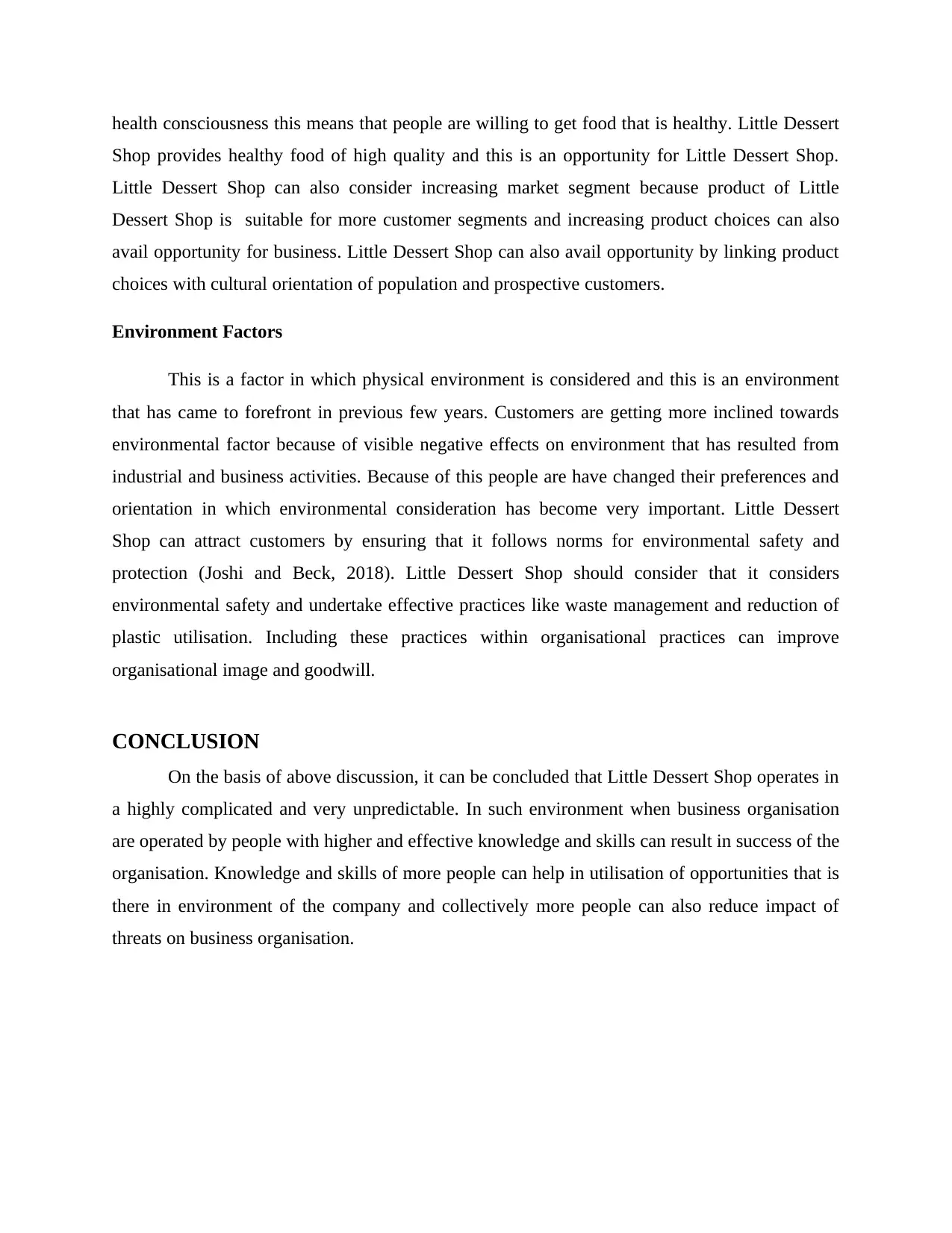
health consciousness this means that people are willing to get food that is healthy. Little Dessert
Shop provides healthy food of high quality and this is an opportunity for Little Dessert Shop.
Little Dessert Shop can also consider increasing market segment because product of Little
Dessert Shop is suitable for more customer segments and increasing product choices can also
avail opportunity for business. Little Dessert Shop can also avail opportunity by linking product
choices with cultural orientation of population and prospective customers.
Environment Factors
This is a factor in which physical environment is considered and this is an environment
that has came to forefront in previous few years. Customers are getting more inclined towards
environmental factor because of visible negative effects on environment that has resulted from
industrial and business activities. Because of this people are have changed their preferences and
orientation in which environmental consideration has become very important. Little Dessert
Shop can attract customers by ensuring that it follows norms for environmental safety and
protection (Joshi and Beck, 2018). Little Dessert Shop should consider that it considers
environmental safety and undertake effective practices like waste management and reduction of
plastic utilisation. Including these practices within organisational practices can improve
organisational image and goodwill.
CONCLUSION
On the basis of above discussion, it can be concluded that Little Dessert Shop operates in
a highly complicated and very unpredictable. In such environment when business organisation
are operated by people with higher and effective knowledge and skills can result in success of the
organisation. Knowledge and skills of more people can help in utilisation of opportunities that is
there in environment of the company and collectively more people can also reduce impact of
threats on business organisation.
Shop provides healthy food of high quality and this is an opportunity for Little Dessert Shop.
Little Dessert Shop can also consider increasing market segment because product of Little
Dessert Shop is suitable for more customer segments and increasing product choices can also
avail opportunity for business. Little Dessert Shop can also avail opportunity by linking product
choices with cultural orientation of population and prospective customers.
Environment Factors
This is a factor in which physical environment is considered and this is an environment
that has came to forefront in previous few years. Customers are getting more inclined towards
environmental factor because of visible negative effects on environment that has resulted from
industrial and business activities. Because of this people are have changed their preferences and
orientation in which environmental consideration has become very important. Little Dessert
Shop can attract customers by ensuring that it follows norms for environmental safety and
protection (Joshi and Beck, 2018). Little Dessert Shop should consider that it considers
environmental safety and undertake effective practices like waste management and reduction of
plastic utilisation. Including these practices within organisational practices can improve
organisational image and goodwill.
CONCLUSION
On the basis of above discussion, it can be concluded that Little Dessert Shop operates in
a highly complicated and very unpredictable. In such environment when business organisation
are operated by people with higher and effective knowledge and skills can result in success of the
organisation. Knowledge and skills of more people can help in utilisation of opportunities that is
there in environment of the company and collectively more people can also reduce impact of
threats on business organisation.
Paraphrase This Document
Need a fresh take? Get an instant paraphrase of this document with our AI Paraphraser

REFERENCES
Books and Journals
Alaka, H.A and et.al., 2017. Insolvency of small civil engineering firms: Critical strategic
factors. Journal of Professional Issues in Engineering Education and Practice. 143(3).
p.04016026.
Cohen, E., 2017. CSR for HR: A necessary partnership for advancing responsible business
practices. Routledge.
Joshi, P. and Beck, K.A., 2018. Cultural, Political, and Economic Factors Affecting the Incentive
to Do Business in BRICS Countries. Perspectives on Global Development and
Technology. 17(5-6). pp.501-515.
Saleem, M.A., 2017. The impact of socio-economic factors on small business
success. Geografia-Malaysian Journal of society and space. 8(1).
Teoh, J., 2017. Learning for performance-a business partnership approach. Training &
Development. 44(2). p.20.
Thaler, T.A., Priest, S.J. and Fuchs, S., 2016. Evolving inter-regional co-operation in flood risk
management: distances and types of partnership approaches in Austria. Regional
Environmental Change. 16(3). pp.841-853.
Tur-Porcar, A., Roig-Tierno, N. and Llorca Mestre, A., 2018. Factors affecting entrepreneurship
and business sustainability. Sustainability. 10(2). p.452.
Wellner, S. and Lakotta, J., 2020. Porter's Five Forces in the German railway industry. Journal of
Rail Transport Planning & Management, p.100181.
Books and Journals
Alaka, H.A and et.al., 2017. Insolvency of small civil engineering firms: Critical strategic
factors. Journal of Professional Issues in Engineering Education and Practice. 143(3).
p.04016026.
Cohen, E., 2017. CSR for HR: A necessary partnership for advancing responsible business
practices. Routledge.
Joshi, P. and Beck, K.A., 2018. Cultural, Political, and Economic Factors Affecting the Incentive
to Do Business in BRICS Countries. Perspectives on Global Development and
Technology. 17(5-6). pp.501-515.
Saleem, M.A., 2017. The impact of socio-economic factors on small business
success. Geografia-Malaysian Journal of society and space. 8(1).
Teoh, J., 2017. Learning for performance-a business partnership approach. Training &
Development. 44(2). p.20.
Thaler, T.A., Priest, S.J. and Fuchs, S., 2016. Evolving inter-regional co-operation in flood risk
management: distances and types of partnership approaches in Austria. Regional
Environmental Change. 16(3). pp.841-853.
Tur-Porcar, A., Roig-Tierno, N. and Llorca Mestre, A., 2018. Factors affecting entrepreneurship
and business sustainability. Sustainability. 10(2). p.452.
Wellner, S. and Lakotta, J., 2020. Porter's Five Forces in the German railway industry. Journal of
Rail Transport Planning & Management, p.100181.
1 out of 8
Related Documents
Your All-in-One AI-Powered Toolkit for Academic Success.
+13062052269
info@desklib.com
Available 24*7 on WhatsApp / Email
![[object Object]](/_next/static/media/star-bottom.7253800d.svg)
Unlock your academic potential
Copyright © 2020–2025 A2Z Services. All Rights Reserved. Developed and managed by ZUCOL.





